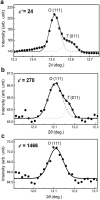Ultrahigh Dielectric Permittivity of a Micron-Sized Hf0.5Zr0.5O2 Thin-Film Capacitor After Missing of a Mixed Tetragonal Phase
- PMID: 40679567
- PMCID: PMC12274175
- DOI: 10.1007/s40820-025-01841-x
Ultrahigh Dielectric Permittivity of a Micron-Sized Hf0.5Zr0.5O2 Thin-Film Capacitor After Missing of a Mixed Tetragonal Phase
Abstract
Innovative use of HfO2-based high-dielectric-permittivity materials could enable their integration into few-nanometre-scale devices for storing substantial quantities of electrical charges, which have received widespread applications in high-storage-density dynamic random access memory and energy-efficient complementary metal-oxide-semiconductor devices. During bipolar high electric-field cycling in numbers close to dielectric breakdown, the dielectric permittivity suddenly increases by 30 times after oxygen-vacancy ordering and ferroelectric-to-nonferroelectric phase transition of near-edge plasma-treated Hf0.5Zr0.5O2 thin-film capacitors. Here we report a much higher dielectric permittivity of 1466 during downscaling of the capacitor into the diameter of 3.85 μm when the ferroelectricity suddenly disappears without high-field cycling. The stored charge density is as high as 183 μC cm-2 at an operating voltage/time of 1.2 V/50 ns at cycle numbers of more than 1012 without inducing dielectric breakdown. The study of synchrotron X-ray micro-diffraction patterns show missing of a mixed tetragonal phase. The image of electron energy loss spectroscopy shows the preferred oxygen-vacancy accumulation at the regions near top/bottom electrodes as well as grain boundaries. The ultrahigh dielectric-permittivity material enables high-density integration of extremely scaled logic and memory devices in the future.
Keywords: Charge storage; Hf0.5Zr0.5O2 thin film; Near-edge plasma treatment; Oxygen vacancy; Ultrahigh dielectric permittivity.
© 2025. The Author(s).
Conflict of interest statement
Declarations. Conflict of interest: The authors declare no interest conflict. They have no known competing financial interests or personal relationships that could have appeared to influence the work reported in this paper.
Figures




Similar articles
-
Ultrahigh dielectric permittivity in Hf0.5Zr0.5O2 thin-film capacitors.Nat Commun. 2025 Mar 18;16(1):2679. doi: 10.1038/s41467-025-57963-8. Nat Commun. 2025. PMID: 40102435 Free PMC article.
-
Zirconium-Rich Strategy in Ultrathin Hf0.5Zr0.5O2 toward Back-End-of-Line-Compatible Ferroelectric Random Access Memory.Adv Sci (Weinh). 2025 Aug 14:e09384. doi: 10.1002/advs.202509384. Online ahead of print. Adv Sci (Weinh). 2025. PMID: 40810730
-
Fatigue-free ferroelectricity in Hf0.5Zr0.5O2 ultrathin films via interfacial design.Nat Commun. 2025 Aug 15;16(1):7593. doi: 10.1038/s41467-025-63048-3. Nat Commun. 2025. PMID: 40817261 Free PMC article.
-
Management of urinary stones by experts in stone disease (ESD 2025).Arch Ital Urol Androl. 2025 Jun 30;97(2):14085. doi: 10.4081/aiua.2025.14085. Epub 2025 Jun 30. Arch Ital Urol Androl. 2025. PMID: 40583613 Review.
-
Electric fans for reducing adverse health impacts in heatwaves.Cochrane Database Syst Rev. 2012 Jul 11;2012(7):CD009888. doi: 10.1002/14651858.CD009888.pub2. Cochrane Database Syst Rev. 2012. PMID: 22786530 Free PMC article.
References
-
- W. Cao, H. Bu, M. Vinet, M. Cao, S. Takagi et al., The future transistors. Nature 620(7974), 501–515 (2023). 10.1038/s41586-023-06145-x - PubMed
-
- S.K. Kim, M. Popovici, Future of dynamic random-access memory as main memory. MRS Bull. 43(5), 334–339 (2018). 10.1557/mrs.2018.95
-
- G. Ribes, J. Mitard, M. Denais, S. Bruyere, F. Monsieur et al., Review on high-k dielectrics reliability issues. IEEE Trans. Device Mater. Reliab. 5(1), 5–19 (2005). 10.1109/TDMR.2005.845236
-
- M. Hoffmann, F.P.G. Fengler, M. Herzig, T. Mittmann, B. Max et al., Unveiling the double-well energy landscape in a ferroelectric layer. Nature 565(7740), 464–467 (2019). 10.1038/s41586-018-0854-z - PubMed
-
- S.S. Cheema, N. Shanker, L.-C. Wang, C.-H. Hsu, S.-L. Hsu et al., Ultrathin ferroic HfO2-ZrO2 superlattice gate stack for advanced transistors. Nature 604(7904), 65–71 (2022). 10.1038/s41586-022-04425-6 - PubMed
LinkOut - more resources
Full Text Sources
Research Materials
Miscellaneous
